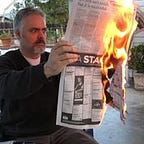ARE WE A STORY OR ARE WE MOMENTS?
Craft Essay by Michael Loveday
A well-written novella-in-flash forces you to pay attention, to care about small moments. It’s designed to be a page-lingerer: one of the aims of flash fiction, despite its name, is to slow us down as we cherish powerful details.
We might say the ‘classic-form’ novella-in-flash is something of a Jekyll-and-Hyde creation. The novella element, as with a traditional novel, usually encourages us to experience narrative progression, where we greedily devour an overarching storyline. But the flash part asks us to savour each discrete scene, sometimes even by re-reading to appreciate and evaluate individual stories. By stringing together a series of flashes within the frame of a central storyline, a novella-in-flash invites us repeatedly to slow to a halt, then move on.
On the one hand, a ‘classic-form’ novella-in-flash conjures up, through its disparate scenes, an overarching plotline glimpsed behind or between the text. A story arc is suggested, and it moves with awareness of chronological time: a narrative clock quietly ticking in the background. This type of writing can be described as ‘teleological’ — which is a fancy way of saying that it has a sense of purpose, and it moves forward towards an endpoint (telos being the Ancient Greek word for ‘end’, ‘purpose’, or ‘aim’).
